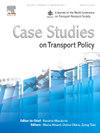Assessment of the barriers in establishing passenger mobility-as-a-service (MaaS) systems: An analogy with multimodal freight transport
IF 2.4
Q3 TRANSPORTATION
引用次数: 0
Abstract
Although the number of Mobility as a service (MaaS) field deployments and studies have increased rapidly in recent years, sustained commercial success remains elusive for many MaaS systems. In this paper, we investigate potential barriers constraining MaaS from wider sustainable success, developing the analogy between passenger-focused MaaS and multimodal freight transport, with the latter having appeared earlier and being subject to more extensive research. We find that the public policy and regulation barriers faced by the two services are broadly similar, whereas operational and infrastructural barriers are very different. Barriers stressed heavily in the multimodal freight transport literature, which may also be important issues preventing greater commercial success of passenger MaaS, include: 1) inadequately understood link between cost efficiency and scale (critical volume, transport distance), 2) the need for seamless intermodal transfer infrastructure, 3) ambiguous stakeholder power structures, 4) importance of guaranteed passenger arrival time service, and 5) immature business models. Due to the inherent differences between MaaS and multimodal freight transport, additional barriers specific to MaaS, such as passengers’ diverse travel demands, physical needs, and concerns around user privacy in information sharing, also warrant further investigation. We hope this paper provides MaaS researchers and practitioners with a novel perspective on the challenges in MaaS development, leveraging insights from multimodal freight transport to anticipate and effectively address future obstacles.
建立乘客移动即服务(MaaS)系统的障碍评估:与多式联运货运的类比
尽管近年来移动即服务(MaaS)的现场部署和研究数量迅速增加,但对于许多MaaS系统来说,持续的商业成功仍然是难以捉摸的。在本文中,我们研究了限制MaaS获得更广泛可持续成功的潜在障碍,将以乘客为中心的MaaS与多式联运货运进行了类比,后者出现得更早,受到了更广泛的研究。我们发现,这两种服务面临的公共政策和监管障碍大致相似,而运营和基础设施障碍则截然不同。多式联运文献中强调的障碍,也可能是阻碍旅客MaaS取得更大商业成功的重要问题,包括:1)对成本效率和规模(临界容量、运输距离)之间的联系理解不充分,2)对无缝多式联运基础设施的需求,3)利益相关者权力结构不明确,4)保证旅客到达时间服务的重要性,以及5)不成熟的商业模式。由于MaaS与多式联运之间的内在差异,MaaS特有的其他障碍,如乘客多样化的旅行需求、物理需求以及对信息共享中用户隐私的担忧,也值得进一步研究。我们希望本文能够为MaaS研究人员和实践者提供一个关于MaaS发展挑战的新视角,利用多式联运货运的见解来预测和有效解决未来的障碍。
本文章由计算机程序翻译,如有差异,请以英文原文为准。
求助全文
约1分钟内获得全文
求助全文

 求助内容:
求助内容: 应助结果提醒方式:
应助结果提醒方式:


